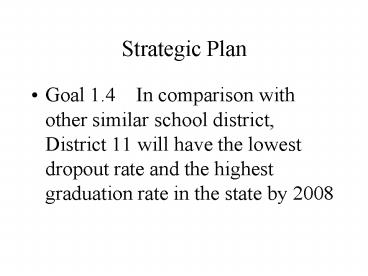Strategic Plan - PowerPoint PPT Presentation
1 / 34
Title:
Strategic Plan
Description:
Strategic Plan Goal 1.4 In comparison with other similar school district, District 11 will have the lowest dropout rate and the highest graduation rate in the state ... – PowerPoint PPT presentation
Number of Views:269
Avg rating:3.0/5.0
Title: Strategic Plan
1
Strategic Plan
- Goal 1.4 In comparison with other similar
school district, District 11 will have the lowest
dropout rate and the highest graduation rate in
the state by 2008
2
What is the Dropout Rate?
- The dropout rate is an annual rate reflecting the
percentage of students who leave school during a
single school year. - It is calculated by dividing the number of
dropouts by the number of students in the
membership base. - By a 1993 legislative mandate, expelled students
are not included in the dropout rate.
3
What is the Graduation Rate?
- The graduation rate is a cumulative or
longitudinal rate which calculates the number of
students who actually graduate as a percent of
those who were in membership and could have
graduated over a four year period. - The membership base is adjusted to accommodate
transfers in or out of the base.
4
2003 Dropout Rate
- District 11 Dropout Rate 4.1
- State Dropout Rate2.4
5
2003 Graduation Rate
- District 11 Graduation Rate67
- State Graduation Rate83.6
6
Why Do Students Drop Out?
- It is common for a student to have multiple
reasons for dropping out. - According to the U.S. Department of Education
- Percentage of dropouts who reported the following
various reasons for dropping out of school
applied to them.
7
School Related
- 51 Did not like school
- 35 Could not get along with teachers
- 20 Could not get along with students
- 15 Suspended too often
- 12 Did not feel safe
- 13 Expelled
- 23 Felt I didnt belong
8
School Related
- 31 Could not keep up
- 39 Failing
- 13 Changed school, did not like new school
9
Job Related
- 14 Could not work and go to school at the same
time - 15 Had to get a job
- 15 Found a job
10
Family Related
- 9 Had to support family
- 13 Was Pregnant
- 14 Became a parent
- 13 Got married
- 8 Had to care for family member
11
Other
- 2 Wanted to travel
- 14 Had friends who dropped out
12
This is a National Problem
- We are part of it
- It is complex
- Research suggests--There is no one size fits
all - Research suggests a multifaceted approach
13
Effective Strategies
- National Dropout Prevention Center
- Clemson University
- Clemson, South Carolina
14
NDPC
- Identified 15 effective strategies that have the
most positive impact on the dropout rate - Four Categories
- School and Community Perspective
- Making the Most of Instruction
- Early Interventions
- Basic Core Strategies
15
School and Community
- School-Community Collaboration
- Project Redirect
- Youth Assessment Center
- Boys and Girls Clubs
- McMaster Center
- Adventures in Learning
16
School and Community
- Safe Learning Environments
- Crimestoppers (CSPD)
- Bullyproofing Curriculum
- School Resource Officers (CSPD)
- Boystown
17
School and Community
- Systemic Renewal
- Continuing process of evaluating goals and
objectives related to school policies, practices,
and organizational structures - Continuous Quality Improvement
18
Making the Most of Instruction
- Professional Development
- Ruby Payne Training
- Dr. Jose Barerra/Multicultural Study with a focus
on Hispanic youth - Professional Learning Communities/Pyramid of
Interventions
19
Making the Most of Instruction
- Individualized instruction
- Individual Learning Plans (ILP)
- Differentiated Instruction
20
Making the Most of Instruction
- Active Learning
- Teaching and learning strategies
- Multiple Intelligences Theory
- Learning Styles
- Cooperative Learning
- Project-Based Learning
21
Making the Most of Instruction
- Educational Technology
- Bridge the Digital Divide
- Provide individualized instruction
- Proving effective for at-risk youth
- Prepare students for the workforce
22
Making the Most of Instruction
- Career and Technical Education
- Business Education Courses
- Consumer and Family Studies Courses
- Industrial Technology Courses
- ACE and Business Internships
23
Early Interventions
- Family Engagement
- Literacy nights
- Parent Connect (now includes phone)
- Youth Assessment Center
24
Early Interventions
- Early Childhood Education
- Headstart Program
- Preschool Programs
- Full-day Kindergarten
25
Early Interventions
- Early Literacy Development
- Tutoring before school, after, and summer
- Corrective Reading
- Guided Reading
- Battle of the Books
- Read 180
26
Basic Core Strategies
- Mentoring/Tutoring
- Grandfriends
- Link Crew
- AFA Partnership w/ Cadets
- Each One Reach One
- Peer Counseling
27
Basic Core Strategies
- Service Learning
- EPYCS
- School Clubs and Teams
- Project Redirect
- Research suggests this is particularly effective
with middle school students
28
Basic Core Strategies
- Alternative Schooling
- Tesla, Bijou, Palmer Night, Doherty Night,
Digital School, Adult Ed., Spring Creek - Lifeskills, Community Prep, Globe, CIVA,
Roosevelt and Emerson-Edison - New Directions
29
Basic Core Strategies
- After-School Opportunities
- After school daycare/Adventure Club
- Boys and Girls Clubs
- After school intramural programs
- Athletics
- Homework Club
- School Clubs
30
Showing Promise
- Student Support Services Coordinator
- Dropout prevention/Dropout recovery
- The Digital School
- Professional Learning Communities
- Pyramid of Interventions
- 9th Grade Summer Institute
31
Next Steps
- Use the work of the National Dropout Prevention
Center as a framework to develop a comprehensive
K-12 dropout prevention/dropout recovery system. - Continually research the work that is being
accomplished on a local and national basis.
32
Next Steps
- Build a system that enables us to identify,
individually, students who are in danger of
dropping out and design interventions that fit
the needs of each.
33
(No Transcript)
34
(No Transcript)































